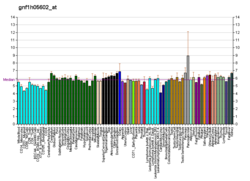| GPR152 |
|---|
|
| Identifiers |
|---|
| Aliases | GPR152, PGR5, G protein-coupled receptor 152 |
|---|
| External IDs | MGI: 2685519 HomoloGene: 35474 GeneCards: GPR152 |
|---|
| Gene location (Human) |
|---|
 | | Chr. | Chromosome 11 (human)[1] |
|---|
| | Band | 11q13.2 | Start | 67,451,301 bp[1] |
|---|
| End | 67,452,729 bp[1] |
|---|
|
| Gene location (Mouse) |
|---|
 | | Chr. | Chromosome 19 (mouse)[2] |
|---|
| | Band | 19|19 A | Start | 4,189,786 bp[2] |
|---|
| End | 4,195,739 bp[2] |
|---|
|
| RNA expression pattern |
|---|
| Bgee | | Human | Mouse (ortholog) |
|---|
| Top expressed in | - spleen
- intestinal epithelium
- lymphatic system
- body of stomach
- endocrine system
- adrenal gland
|
| | Top expressed in | - connective tissue
- white adipose tissue
|
| | More reference expression data |
|
|---|
| BioGPS |  | | More reference expression data |
|
|---|
|
| Gene ontology |
|---|
| Molecular function | - signal transducer activity
- G protein-coupled receptor activity
| | Cellular component | - integral component of membrane
- plasma membrane
- membrane
- integral component of plasma membrane
| | Biological process | - G protein-coupled receptor signaling pathway
- signal transduction
| | Sources:Amigo / QuickGO |
|
| Orthologs |
|---|
| Species | Human | Mouse |
|---|
| Entrez | | |
|---|
| Ensembl | | |
|---|
| UniProt | | |
|---|
| RefSeq (mRNA) | | |
|---|
| RefSeq (protein) | | |
|---|
| Location (UCSC) | Chr 11: 67.45 – 67.45 Mb | Chr 19: 4.19 – 4.2 Mb |
|---|
| PubMed search | [3] | [4] |
|---|
|
| Wikidata |
| View/Edit Human | View/Edit Mouse |
|


















